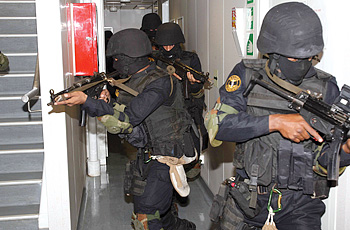INDIAN ARMED FORCES CHIEFS ON
OUR RELENTLESS AND FOCUSED PUBLISHING EFFORTS

SP Guide Publications puts forth a well compiled articulation of issues, pursuits and accomplishments of the Indian Army, over the years

I am confident that SP Guide Publications would continue to inform, inspire and influence.

My compliments to SP Guide Publications for informative and credible reportage on contemporary aerospace issues over the past six decades.
Security
Quest for Safe Coast

The 26/11 attack jolted the Indian security, exposed the prevailing gaps in the coastal surveillance apparatus
It has been two years since the financial capital of the country, Mumbai, was put under a devastating siege by a handful of pakistani terrorists. This attack on Mumbai on November 26, 2008 had brought the Indian maritime security environment under intense spotlight and scrutiny. It raised issues that have been under the media and political scanner since the 1990s. Following the 1993 bomb blasts, the sea route and the susceptible coastal security environment were identified as the likely loopholes in the country’s security ring. Various committees recommended measures, such as regulation of fishing traffic, enhancing port security environment, gazettes for empowering maritime agencies for enforcing maritime zones of India (MZI) provisions, putting in place a maritime governing body, coastal radar stations, among others. Whilst all these recommendations have been reiterated, and in some cases also accepted, the challenges to Indian coastal security remain high.
As on date, threats to our coastal areas are mainly sub-conventional in nature. Terrorist have the potential to attack our vital installations located along the coasts, such as atomic power complexes, oil platforms, naval bases, industrial assets and cities, causing substantial damage. Smuggling of drugs, arms and explosives via the sea route by criminal groups aggravates the coastal security scenario further. Criminal groups engaging in these activities not only breach the security of the coast but also network with terrorists and provide logistical support for their dreaded operations. Indian coasts are also vulnerable to illegal migration from Bangladesh and Sri Lanka. Though such people do not pose a direct security threat, the probability exist that terror operatives can sneak into the country in the guise of such migrant populace. Finally, numerous fishing boats which venture into the sea each day also pose a security threat, as many such fishing boats could be used for smuggling-in arms and infiltrators, as was done by the 26/11 perpetrators, when they forcibly took over the fishing vessel Kuber that arrived on Mumbai’s shores. The situation is aggravated by the fact that checking each one of these tens of thousands of boats for suspicious men and material is almost impossible.
The 26/11 attacks were a massive jolt to Indian security, which till then was perceived to emanate only from our northerly land frontiers. After the Mumbai siege, amid concerns about the security of India’s coast, the media highlighted reports regarding gaps in the coastal surveillance apparatus. This terror attack was so immense that it compelled the central government to announce a slew of measures to revamp coastal security.
More sea power
The foremost was entrusting the responsibility of guarding the coast, to the Coast Guard (CG) and overall responsibility for maritime security to the Indian Navy, including creation of Sagar Prahari Bal, and early procurement of interceptor boats, offshore vessels and helicopters. The Navy and the Coast Guard are key members of India’s maritime security and law enforcement system, functioning independently, yet interdependently. To counter the multitude of threats envisaged in the future, it is imperative that the Indian Navy and the CG, as the principal stakeholders in the maritime domain, operate in a very cohesive and synergistic manner. The charters in respect of these agencies have been very clearly defined and laid down. The Indian Coast Guard (ICG), when formed in 1978, was mandated with the responsibilities in MZI, in line with the issues perceived to be relevant at that point in time. Accordingly, ICG was provided appropriate assets to tackle issues pertaining to violations in exclusive economic Zone (EEZ) and search and rescue (SAR), and later added the mandate of Maritime pollution. since then, in the last four decades, the MZI domain has seen the mushrooming of various concerns including maritime terrorism, illegal arms trafficking, among others. Further, India’s peninsular geography remains more prone to maritime incidents view the country’s location in the Indian ocean region (IOR) and the geopolitical issues therein. It is for this reason that post-26/11, the Cabinet Committee on security (CCS) had sanctioned for the Coast Guard, 40 ships, 20 boats and 42 aircraft in February 2009 and later accepted the need for another seven offshore patrol vessels, 20 fast patrol vessels and 12 dornier aircraft. Further, recruitment of the 3,000 additional personnel was also authorised. Investments of this scale were mandated, as India has a 7,500-km-long coastline which touches nine states and four Union territories and is dotted with 12 major and 180 minor ports.
At the state level, reviewing the country’s coastal security in the wake of the terror strikes in Mumbai, the state governments were directed to operationalise all coastal police stations and check posts. To ensure better coordination among different agencies, Coastal Command and Joint operation Centres had been set up. In october 2010, Home Minister p. Chidambaram stated that the identified gaps which remain to be filled up would be plugged through phase-II of the Coastal security scheme. Phase-I of the Coastal security scheme would come to an end in March 2011. Phase-II, to be launched thereafter, will considerably strengthen infrastructure in terms of boats, police stations, jetties, vehicles, equipment, trained personnel, among others. Compulsory registration of all types of vessels like fishing as well as non-fishing vessels, provision of navigational and communication equipments in all type of vessels and issuance of biometric ID cards to all the fishermen are among the provisions under the scheme.





